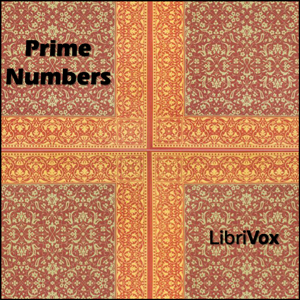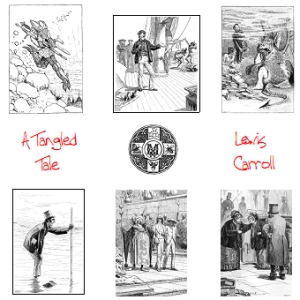A recording of the first 2000 prime numbers (2-17389). Recommended listening for all math geeks and insomniacs!
2 episodes
Lewis Carroll (1832 - 1896) is best known for 'Alice's Adventures in Wonderland'. It is less widely known that he worked as a lecturer for mathematics at Christ Church college, Oxford for 27 years. 'A tangled tale' merges his two talents as storyteller and mathematician. It consists of 10 short humorous stories which present one or more mathematical problems. The 10 'knots' as they are called, were first published in 'The Monthly Packet' magazine between April 1880 and March 1885, where readers were invited to solve the problems, and the solution was discussed in a later issue. (Summary by Availle)
20 episodes

In January 1909 a friend of the Scientific American paid the sum of 500$ which was to be awarded as a prize for the best popular explanation of the Fourth Dimension. The object being to set forth in an essay not longer than 2500 words the meaning of the term so that the lay reader could understand it. 245 essays were submitted, the 500$ prize was awarded to Lieut.-Col. Graham Denby Fitch, Corps of Engineers, USA, and the essay was published in the Scientific American of July 3rd 1909.
Despite the character of the subject, extraordinary interest was manifested in the contest. Competitive essays were received from almost every civilized country. Because of this unexpected interest in the subject, it has seemed advisable to preserve a few of the essays which were submitted. Prof. Henry P. Manning (Brown Univ.) has chosen essays which lend themselves best for the purpose of a popular book on the Fourth Dimension, in other words, those which present the subject from as many different points of view as possible.
This book contains 22 of the submitted essays, starting with the prizewinning one, followed by three that received an honorable mention. (Summary adapted from the preface by Availle).
25 episodes
Calculus Made Easy: Being a Very-Simplest Introduction to Those Beautiful Methods of Reckoning which Are Generally Called by the Terrifying Names of the Differential Calculus and the Integral Calculus is is a book on infinitesimal calculus originally published in 1910 by Silvanus P. Thompson, considered a classic and elegant introduction to the subject. (from Wikipedia)
Some calculus-tricks are quite easy. Some are enormously difficult. The fools who write the textbooks of advanced mathematics—and they are mostly clever fools—seldom take the trouble to show you how easy the easy calculations are. On the contrary, they seem to desire to impress you with their tremendous cleverness by going about it in the most difficult way.
Being myself a remarkably stupid fellow, I have had to unteach myself the difficulties, and now beg to present to my fellow fools the parts that are not hard. Master these thoroughly, and the rest will follow. What one fool can do, another can. (from the Prologue)
58 episodes
"The Royal Society is a Fellowship of many of the world's most eminent scientists and is the oldest scientific academy in continuous existence." (from its Mission Statement). As scientists have explored the world around them, observed and tried to explain natural phenomena, they have been invited to present papers to the Royal Society. Edmond Halley (of Halley's Comet fame) was an eminent member of the society and gathered together some of the most interesting papers of his day. Today, we may see errors in the logic or calculations, based on current knowledge, but these papers are unedited and as presented at the time and show how scientific knowledge was expanding in the late seventeenth and early eighteenth centuries. Summary by Lynne Thompson
30 episodes

"Mr Hinton tries to explain the theory of the fourth dimension so that the ordinary reasoning mind can get a grasp of what metaphysical mathematicians mean by it. If he is not altogether successful, it is not from want of clearness on his part, but because the whole theory comes as such an absolute shock to all one's preconceived ideas" - The Bristol Times (quoted within the book).
This book was published in 1912. The author is attempting to communicate a very complex interweaving of philosophy and mathematics, and it is often difficult to follow his train of thought. However, it is hard to refute his idea of a four dimensional universe passing through and, in a way, creating our three dimensional one.
For sections 1-9, the reader attempted to describe the illustrations in the text, but as the pictures were getting more complex, a separate PDF file of illustrations was created, copied from the pages of the book. It can be downloaded from the catalog page on archive.org or via the link "Extracted illustrations of the book" on the left side below. (Summary by Peter Yeasley)
29 episodes

Some men write their lives to save themselves from ennui, careless of the amount they inflict on their readers.
Others write their personal history, lest some kind friend should survive them, and, in showing off his own talent, unwittingly show them up.
Others, again, write their own life from a different motive—from fear that the vampires of literature might make it their prey.
I have frequently had applications to write my life, both from my countrymen and from foreigners. Some caterers for the public offered to pay me for it. Others required that I should pay them for its insertion; others offered to insert it without charge. One proposed to give me a quarter of a column gratis, and as many additional lines of eloge as I chose to write and pay for at ten-pence per line. To many of these I sent a list of my works, with the remark that they formed the best life of an author; but nobody cared to insert them.
I have no desire to write my own biography, as long as I have strength and means to do better work.
The remarkable circumstances attending those Calculating Machines, on which I have spent so large a portion of my life, make me wish to place on record some account of their past history. As, however, such a work would be utterly uninteresting to the greater part of my countrymen, I thought it might be rendered less unpalatable by relating some of my experience amongst various classes of society, widely differing from each other, in which I have occasionally mixed.
This volume does not aspire to the name of an autobiography. It relates a variety of isolated circumstances in which I have taken part—some of them arranged in the order of time, and others grouped together in separate chapters, from similarity of subject.
The selection has been made in some cases from the importance of the matter. In others, from the celebrity of the persons concerned ; whilst several of them furnish interesting illustrations of human character. - Summary by From the Preface
40 episodes
When Albert Einstein published his first paper on relativity theory, it caused a stir in the physicists' community. When more and more evidence was gathered to prove the theory correct, even laymen became interested in it. Since the theory of relativity uses involved higher mathematics, it is considered notoriously difficult to grasp, and at the time it was published, it was claimed that only 12 people in the world were able to fully understand it. One of these was the Dutch physicist Hendrik Lorentz, who wrote the articles collected in this book for a lay audience. He explains the basics of the theory in clear and concise terms without needing any mathematics. All that is needed to fo follow his arguments is a bit of patience and time. (Summary by Availle)
7 episodes







